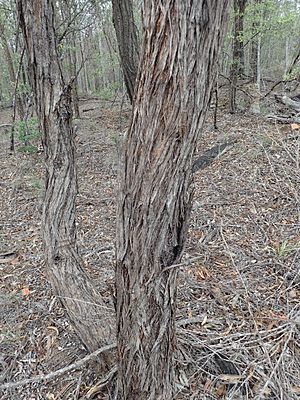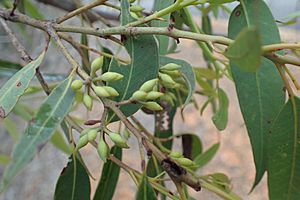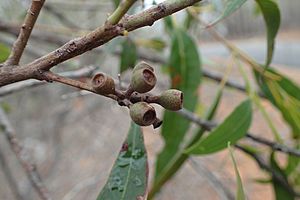Eucalyptus helidonica facts for kids
Quick facts for kids Eucalyptus helidonica |
|
|---|---|
 |
|
| Eucalyptus helidonica near Helidon | |
| Scientific classification | |
| Genus: |
Eucalyptus
|
| Species: |
helidonica
|
The Eucalyptus helidonica is a special type of tree that grows only in one area near Helidon in Queensland, Australia. It has rough, stringy bark and long, curved leaves that are lighter on their underside. This tree produces white flowers and unique, barrel-shaped fruits.
Contents
About the Helidon Ironbark Tree
The Eucalyptus helidonica usually grows to be about 20 metres (66 ft) tall. It has a special woody lump at its base called a lignotuber. This lignotuber helps the tree regrow if it gets damaged, for example, by a bushfire.
Its bark is rough and grey or grey-brown on the main trunk and bigger branches. However, the bark on its smaller branches is smooth.
Leaves
Young Eucalyptus helidonica plants and new shoots have long, narrow leaves. These leaves are attached directly to the stem without a stalk and grow in pairs opposite each other. They are lighter green underneath. These young leaves are about 60–135 mm (2.4–5.3 in) long and 7–18 mm (0.28–0.71 in) wide.
As the tree gets older, its leaves change. Adult leaves are shaped like a spear or are slightly curved. They are a dull green color but are paler on their underside. These leaves are typically 60–145 mm (2.4–5.7 in) long and 90–250 mm (3.5–9.8 in) wide. They narrow down to a leaf stalk, called a petiole, which is about 9–20 mm (0.35–0.79 in) long.
Flowers and Fruit
The flower buds of the Eucalyptus helidonica grow in groups of eleven or more. They are found where the leaves meet the stem. Each group of buds sits on a main stalk, called a peduncle, which is 10–25 mm (0.39–0.98 in) long. Each individual bud has its own small stalk, called a pedicel, about 3–5 mm (0.12–0.20 in) long.
When the buds are ready, they are oval-shaped, about 4–5 mm (0.16–0.20 in) long and 2 mm (0.079 in) wide. They have a cone-shaped cap on top, called an operculum. The flowers themselves are white.
After the flowers bloom, the tree produces woody fruits. These fruits are shaped like a shortened sphere or a barrel. They are about 4–6 mm (0.16–0.24 in) long and 4–7 mm (0.16–0.28 in) wide. Inside, the parts that open to release seeds, called valves, are either near the rim or hidden inside the fruit.
Naming and Classification
How it Got its Name
The Eucalyptus helidonica was officially described for the first time in 1999 by a botanist named Kenneth Hill. He published his description in a science journal called Telopea.
The second part of its scientific name, helidonica, comes from the town of Helidon. This is because the tree is mainly found in the area around Helidon.
Part of a Special Group
Kenneth Hill also recognized that Eucalyptus helidonica belongs to a group of trees called the "white mahogany group." Other trees in this group include E. acmenoides, E. mediocris, E. carnea, E. apothalassica, E. latisinensis, E. psammitica, and E. umbra.
Where it Lives
This special gum tree is found only in a small area around the town of Helidon. This town is located west of Brisbane in Queensland, among the Great Dividing Range.
The Eucalyptus helidonica grows in dry sclerophyll woodlands. These are types of forests where trees and shrubs have hard, tough leaves to survive dry conditions. You can find this tree growing on sandstone ridges and slopes, usually in sandy soils.
Conservation Status
The Queensland Government has a list of plants and animals and how safe they are. Under their Nature Conservation Act 1992, the Eucalyptus helidonica is classified as "least concern." This means that there are enough of these trees, and they are not currently at risk of disappearing.




